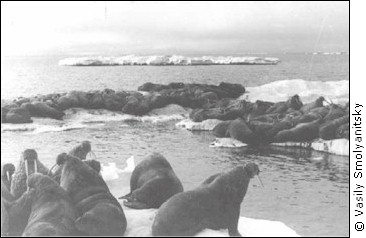 |
|
Polar bears and walrus are two of many Arctic animals testing POP-positive.
|
|

|
In his research lab in the biology department at the University of Ottawa, Dr. Jules Blais studies the chemicals that make their way to the Arctic and persist not despite, but because of the harsh climate.
Chemicals like DDT — banned for nearly two decades in North America because it was toxic to many more organisms than it was intended to kill.
Chemicals like those in your car exhaust, lawn pesticide and fire extinguisher.
Persistent organic pollutants or POPs, with a mysterious home in the Arctic.
Blais' research offers valuable insight to the secrets of these chemicals and is invaluable to the production and monitoring of new chemicals.
According to Blais, the cold that keeps us away from the far North is exactly what lures the toxins we produce to leave the air and join the Arctic snow and ice. Once there, they melt into the waters where they become one with animals from the lowest to the highest level of the food chain.
POPs and the cold
|
POP Shop
|
| PCB's (polychlorinated biphenyls) |
- manufactured in the United States, Japan, the former Soviet Union
- chemically stable and heat resistant
- used as transformer and capacitor oils and hydraulics
- restricted usage in many countries
|
| Dioxins and furans |
- chlorinated chemicals
- released in wood burning stoves and use of leaded fuel
|
| Brominated flame retardants |
- leak out of textiles, electrical equipment, building material and car interiors treated with flame retardants
- knowledge is limited, NO restrictions
- the object of a current AMAP study in Yellowknife, NWT
|
| DDT |
- chlorinated organic pesticide
- banned in North America but still used in Southern Asia, Africa, Central and South America and parts of Europe
|
| Lindane |
- insecticide used to treat hardwood logs, lumber, seed fruit and vegetables
|
| Mirex |
- used as an insecticide and flame retardant in Canada in 1978
- implicated in cancer, has reproductive effects in lab animals
|
How can these chemicals used in the most southern of countries to control insects and benefit agriculture find their way to the Arctic where fields are expanses of ice and snow?
According to Blais, POPs are capable of traveling very long distances: from far away in the Eastern world up to the Canadian Arctic.
Blais attributes their "jet-set" lifestyle to their freezing points. That is, most POPs have very low freezing points, much lower than water. They won't fall from the sky as snow or rain until the air has lost its density and the temperature cools to Arctic standards. The lower the POPs' freezing point, the farther and the higher they can travel.
On the ground, they freeze into Arctic glaciers. Part of the ice, they can melt to become part of our lakes and streams.
Into our water, into our food
Dr. Blais' work took him to Bow Lake in Alberta where he and his researchers determined that 50 to 97 per cent of subalpine lake water is from these melting glaciers. Even more significantly, they discovered that 10 per cent of the chemicals found in the lake were form ice that melted 55 to 75 years ago.
This knowledge helps scientists to explain how chemicals like DDT, although no longer in use, are still found in our environment and affect life at all levels of the food chain. In fact, animals at the top of the food chain, like seals, polar bears and humans, end up with a much higher chemical concentration their tissues than the species they consume.
Dr. Blais says this because POPs biomagnify. POPs rapidly assimilate in the fats of animals and are metabolized very slowly. So chemicals enter the body at a much faster rate than they leave the body.
Fishes on dishes
Given the POPs' tendency to accumulate in fatty tissue and biomagnify through the food web, populations in northern environments are highly susceptible. Storing energy as fat is crucial for survival in cold environments. Fat is therefore important in the diets of both people and animals, which increases their intake of these pollutants.
Fish is a main staple in the diet of Broughton Islanders in the Northwest Territories. Researchers found that human mother's milk was concentrated with POPs called "PCBs" — up to 47 times the tolerable daily intake for an adult.
Because many POP studies are fairly recent, scientists have been unable to attribute any direct health effect of POPs on humans.
Studies done with animals, however, populations revealed malformations in reproduction organs and fewer young. Even complete failure to reproduce was common in areas with high contamination levels.
Several POPs are also suspected of causing tumours in wildlife in polluted areas and affecting the immune systems, making animals more susceptible to infections.
Future Trends
AMAP (Arctic Assessment Monitoring Program), Canada's Northern Contaminants Programs and other programs have been the result of research like Dr. Blais' and other studies done by organizations like the Environmental Health Institute.
The case of DDT makes one thing clear: the most innovative and revolutionary chemicals have the potential to harm and once frozen in Arctic glaciers their consequences may be seen for years to come.
|

